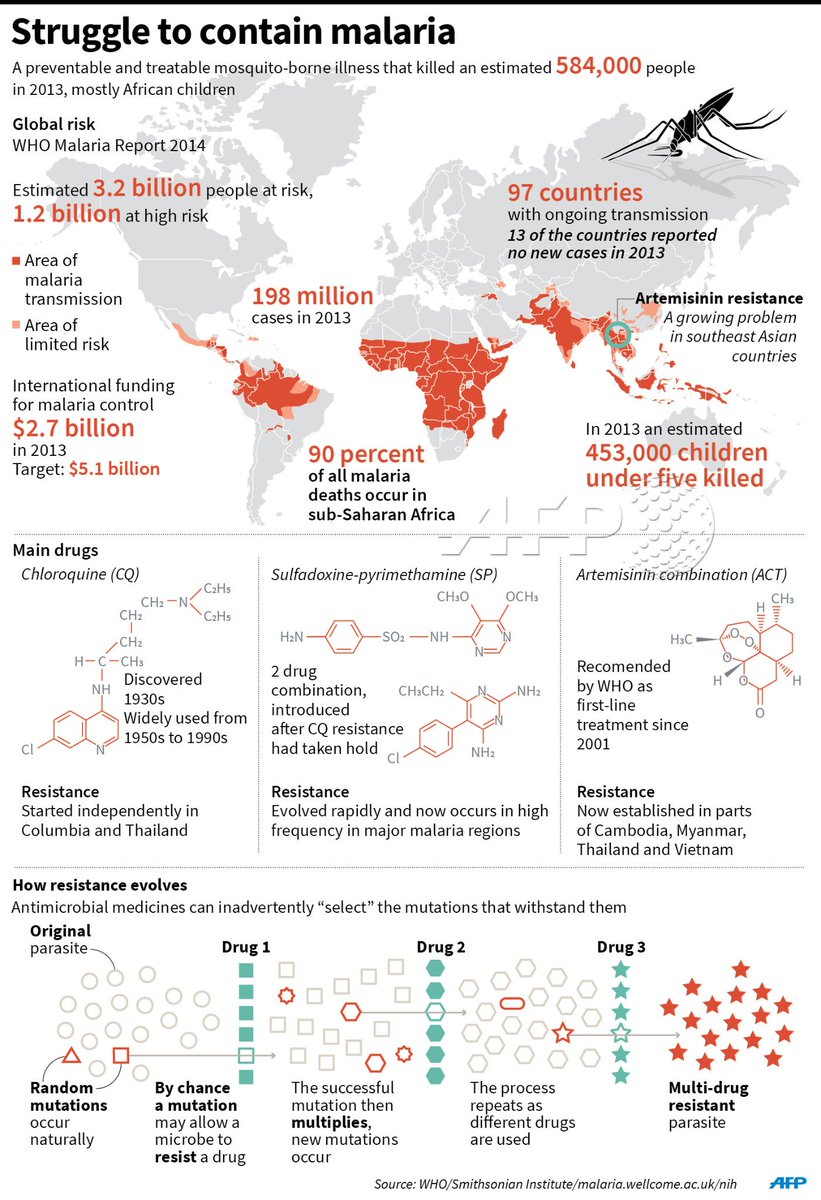Timely infographic from Agence France Presse.
Some background: The newly-formed World Health Organization (WHO) estimated worldwide malaria deaths at more than 5 million per year, when it kicked off the ambitious but ultimately unsuccessful malaria eradication program in 1955. Eradication hopes hung on the use of DDT, sprayed on the walls of homes in affected areas (Indoor Residual Spraying, or IRS), to temporarily knock down mosquito populations so that humans infected with malaria could be cured. After early successes in temperate zones, malaria fighters took the fight to tropical Africa in 1963. There they discovered that overuse and abuse of DDT had already bred mosquitoes resistant to the pesticide. With no substitute for DDT available, WHO wound down the campaign on the ground by 1965, and officially abandoned it in 1969.
Nations who had pledged money for the fight early, cut back when DDT failed. In 1963, about 4 million people died from malaria, worldwide.
Despite the lack of an international, worldwide fight against malaria, malaria fighters soldiered on. Better housing and better medicines made gains. By the time the U.S. banned DDT use on crops in 1972, pledging all U.S. production of DDT to fight disease elsewhere, annual malaria deaths had fallen to just over 2 million per year. By 1990, the annual death toll was cut to about a million per year. Through the 1980s, malaria parasites themselves developed resistance to the main pharmaceuticals used to cure humans.
By the end of the 1990s, international agencies and especially NGOs like the Bill and Melinda Gates Foundation brought new funding and new urgency to the fight against malaria. Expansion of production of artemisinin-based pharmaceuticals provided a new tool for health workers. Funding from the U.S., through the President’s Malaria Initiative, helped a lot. In 2000, about a million people died from malaria. By 2014, malaria deaths fell to under 600,000.
Parasite resistance to the new pharmaceuticals poses a new threat to continued progress. Funding is still far short of what experts estimate to be needed, and short of pledges from developed nations. Mosquitoes that carry malaria parasites from human to human (after a step of the life cycle in infected mosquitoes) quickly evolve resistance to pesticides; malaria parasites develop resistance to pharmaceuticals used to treat humans. Funding to rotate pesticides and drugs falls short, causing improper use of both, and quicker evolution of resistance in mosquitoes, and parasites.








Reblogged this on pebbiesunshine's Blog and commented:
If only we would just keep our environments clean in Africa and provide clean water, it would reduce more diseases
LikeLike
Wow! All I know is that if Africa keeps her environment clean,there will be less people dying of malaria, if only African leaders prioritize their first when it come to a clean environment and health care facilities that improve the lives of their citizens, there won’t be so much need for much chemicals to kill mosquitoes as its a known fact that Mosquitoes breed in unclean environment. Thanks for the write up.
LikeLike
[…] collapsed, not exploded. From 1963’s ~4 million annual deaths to malaria, annual death toll in 2014 was less than 600,000. Deaths were cut by more than 80%. From 1963’s 500 million people infected, totals fell to […]
LikeLike
I think it is so important to keep this information in front of people. Since organisms that cause diseases to humans, or which develop taste for our foods, are often so quick to develop immunity to our arsenal of chemicals to combat them, and since so many other forms of life don’t, I believe it is high time to reevaluate our position.
It strikes me as horribly arrogant to assume that we, as one species, get to destroy life at will just because we feel threatened. Especially when, say, a screen on a window can do the job as well.
When we look at other species, we see diseases rise when their populations rise and become dense. This is the natural order of things. Perhaps rather than declare war on other forms of life, we could simply curb our population.
LikeLiked by 1 person